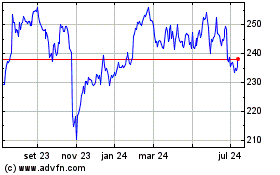Ahead of Wall Street for October 6, 2012 - Ahead of Wall Street
05 Outubro 2012 - 6:17AM
Zacks
Friday, October 5, 2012
The September jobs report is the big news of the day, both for the
markets as well as political partisans. From the market’s
perspective, the report is not materially different from what we
have been seeing in recent months, though it does carry a few
positive internals.
The key positives are in the drop in the unemployment rate and the
positive revisions to the preceding two months. But with elections
around the corner, the report will have a bearing on the political
debate as well. And on that front, the report has something for
everyone – different parts of the reports can spun in different
ways. That said, the bottom line is that it’s a net-positive
report.
The Bureau of Labor Statistics (BLS) reported September non-farm
payroll gains of 114K, broadly in-line with expectations, but
August’s 142K tally (August was revised higher from 96K). The
revisions trend was clearly positive – with August and July both
revised higher, but with the revisions appear to be mostly in
government jobs, which turned from negative to positive.
The unemployment rate ticked down to 7.8% from 8.1% last month,
driven primarily by very strong gains in the Household survey. The
Household survey showed 873K jobs added in September, after several
months of tepid gains, and helped bring down the unemployment rate
below the 8% level for the first time since early 2009.
Wednesday’s ADP (ADP) report of strong private
sector job gains appears to have been off the mark this month
again, as was the case in August. A total of 104K private sector
jobs were created in September, compared to 97K in August, with the
government sector adding 10K. The ADP report showed private-sector
job gains of 162K in September.
Manufacturing lost 16K jobs in September, compared to 22K jobs lost
in August, while service sector jobs totaled 114K, compared to job
gains of 119K in August and 143K in July. The manufacturing decline
is particularly worrying as the factory sector was consistently
adding jobs in this recovery, but seems to have lost steam lately
even though the latest ISM survey showed a rebound. The average
workweek ticked up to 34.5 hours from 34.4 hours last in August,
while average hourly earnings increased $23.58 from $23.51 last
month.
Today’s jobs report is modestly on the positive side, though
payroll gains have by all means been underwhelming in recent
months. Leading indicators of labor market growth like weekly
jobless claims, the ISM surveys, and the ADP data are not showing
any signs of improvement from that monthly pace either. The fact is
that we will not see acceleration in the pace of job creation till
the U.S. economy’s growth pace accelerates. The economy expanded at
the rate of 1.6% in the first half of the year and is not expected
to grow materially faster in the second half of the year.
It
may seem like the chicken-and-egg problem – you need jobs to
accelerate GDP growth and a growing economy to create more jobs.
But it actually is not, as there is no doubt about what needs to
come first – GDP growth needs to accelerate. But what will be the
catalyst(s) for that growth in our Rogoff & Reinhart
world?
The signs of life on the housing front are definitely encouraging
and the Fed’s focus on that sector through its QE3 program may hold
some promise. Can housing push the economy out of the stall-speed
it has been stuck in for a while now?
Sheraz Mian
Director of Research
AUTOMATIC DATA (ADP): Free Stock Analysis Report
To read this article on Zacks.com click here.
Zacks Investment Research
Want the latest recommendations from Zacks Investment Research?
Today, you can download 7 Best Stocks for the Next 30 Days. Click
to get this free report
Automatic Data Processing (NASDAQ:ADP)
Gráfico Histórico do Ativo
De Jun 2024 até Jul 2024

Automatic Data Processing (NASDAQ:ADP)
Gráfico Histórico do Ativo
De Jul 2023 até Jul 2024
